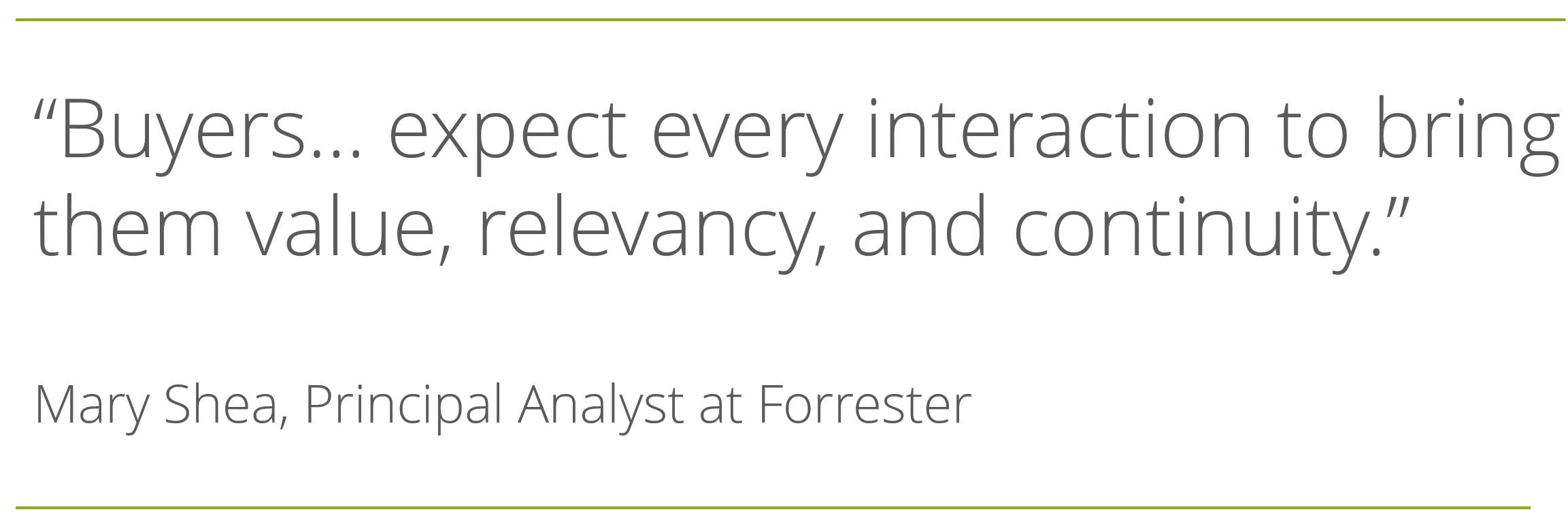In 2021, sales leaders that ground their communications in storytelling—and guide customers to a central BIG Idea—will beat out the competition.
In 2020, industries that were slow to dip their toes in the digital-first waters had to adopt technology and virtual selling at an accelerated pace. Now, global sales teams are quickly transitioning from being “forced” to adapt to lockdowns to recognizing that online selling is here to stay—and that it’s not necessarily a bad thing.
In fact, research by McKinsey shows that more than three quarters of B2B buyers and sellers actually prefer remote human engagement over face-to-face interactions.
On one hand, this may seem like an advantage for sales teams—buyers can readily access a wealth of information online that they can utilize to make smart purchasing decisions. On the other hand, the sheer amount of information is also causing customers to feel overwhelmed, resulting in delayed or abandoned purchases.
Customers are left to their own devices (both literally and figuratively) while navigating all that’s available online, which means the key selling point might be getting missed.
With more emphasis than ever on the digital customer journey, you’ve probably read loads of predictions for 2021 that concentrate on virtual selling environments and tools to support digital marketing. But many sales leaders are overlooking one key trend that’s been around far longer than any trendy piece of technology: storytelling.
Using Storytelling in a Virtual World to Be More Effective
In today’s oversaturated environment, sales leaders must look beyond the tech-enabled tools and acknowledge what many of the forecasted trends for next year are missing: the need for effective storytelling.
Whether face-to-face or remote, the best salespeople know how to impart a rock-solid narrative that gets straight to the point.
Sales leaders must ensure their teams get to the root cause of the issue their buyers are facing. This requires salespeople to walk in their buyers’ shoes and see things from their point of view, or risk missing a larger opportunity. Oftentimes, salespeople get stuck in the tactical items and fail to direct the customer to think about their business in a different light.
Once the root cause has been identified, sellers must frame up their narrative in a way that creates excitement and motivates the customer to action. In many cases, over-reliance on facts and data get in the way of communicating the BIG Idea. More time must therefore be spent on discovering the story that drives audiences to act.
Driving this BIG Idea home with executive presence requires a deliberate approach on the part of a salesperson to flex their story based on the various needs and interests of each buyer. For instance, the senior executive in your audience likely has different priorities than the product engineer that’s also in the room. Adjusting your story (with your audience’s mindset always at the forefront) not only helps you meet the information needs of different audiences, but it helps you anticipate questions and command the room.
But what exactly is storytelling in the world of sales? While definitions abound, it all boils down to brands sharing their message in a way that engages audiences and drives them to a desired action.
“Buyers… expect every interaction to bring them value, relevancy, and continuity”
-Mary Shea, Principal Analyst at Forrester
Storytelling helps customers immediately connect with what you’re selling on an emotional level, making it easy to gather the facts, weigh their options, and make a decision.

The BIG Idea: How to Communicate the Sum and Substance
Of course, storytelling in business is not a new trend. But there is one key component that can make or break a business narrative when selling your product or service, and that’s having one BIG Idea.
Your BIG Idea is the one key message you want your audience to remember. They need to be able to understand—and remember—this point easily, whether you’re engaging them online or face-to-face. (Yes, it works no matter how you deliver your ideas—even in emails!)
When telling your story, every fact, figure, and insight within your narrative should tie back to this BIG Idea. The goal is to clarify the idea in such a way that resonates with your customers emotionally, making them feel a strong connection to your story.
Think about it like this: your BIG Idea is the subject line of your most hard-hitting, impactful, and click-worthy email. If you only had one chance to send out an email to your entire network explaining your main selling point, what would the subject line be?
It wouldn’t make sense to include something vague—like “meeting agenda” or “product update.” Rather, your BIG Idea needs to address the central issue that your audience cares about.
As we look to 2021, sales leaders that help customers make sense of what they’re seeing and guide them to the central, BIG Idea will come out on top.
While the opportunities created by digital selling environments are undoubtedly exciting, the future of sales trends will be defined by a sense-making approach and a core focus on storytelling.
Today’s customers want to feel confident in what they learn and engage with online, and it’s up to the seller to drive forth a solid narrative and BIG Idea that makes the learning journey clear-cut and painless.
Want to learn more about up-leveling your sales teams’ storytelling skills in 2021? Check out our Corporate Storytelling Workshop for Teams or order your copy of our new book, Everyday Business Storytelling.
